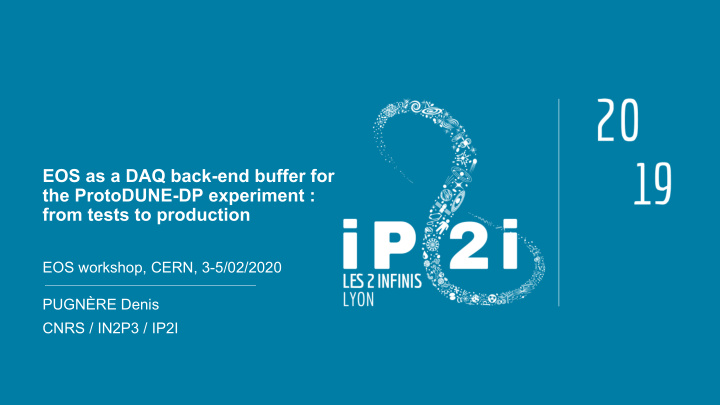



EOS as a DAQ back-end buffer for the ProtoDUNE-DP experiment : from tests to production EOS workshop, CERN, 3-5/02/2020 PUGNÈRE Denis CNRS / IN2P3 / IP2I
EOS workshop, CERN, 3-5/02/2020 PUGNÈRE Denis - CNRS / IN2P3 / IP2I
ProtoDUNE dual-phase experiment needs ProtoDUNE dual-phase : 146.8MB / event, trigger rate 100Hz 7680 channels, 10 000 samples, 12 bits (2.5Mhz : drift window 4ms) : => data rate 130Gb/s ProtoDUNE dual-phase online DAQ storage buffer specifications : • ~1 PB (needed to buffer several days of raw data taking) • It should to store files at a 130Gb/s data rate (raw, no compression) • It should allow: fast online reconstruction to perform data quality monitoring, and online analysis for assessment of detector performance • Data moved to the CERN EOSPUBLIC instance via a dedicated 40Gb/s link EOS workshop, CERN, 3-5/02/2020 PUGNÈRE Denis - CNRS / IN2P3 / IP2I
Storage system tested (2016) EOS workshop, CERN, 3-5/02/2020 PUGNÈRE Denis - CNRS / IN2P3 / IP2I
EOS workshop, CERN, 3-5/02/2020 PUGNÈRE Denis - CNRS / IN2P3 / IP2I
Storage back-end choice : EOS • EOS chosen (after the 2016 tests) : • Low-latency storage , • Very efficient on the client side (XrootD based), • POSIX, Kerberos, GSI access control, • XrootD, POSIX file access protocol, • 3rd party-copy support (used for FTS), • Check-sums support, • Redundancy (old hardware, remote operating) : • Meta-data servers • Data server (2 replicas or RAIN raid6/raiddp) <- not yet used • Data server life-cycle management (draining, start/stop operation) EOS workshop, CERN, 3-5/02/2020 PUGNÈRE Denis - CNRS / IN2P3 / IP2I
ProtoDUNE Dual-Phase DAQ back-end design EOS workshop, CERN, 3-5/02/2020 PUGNÈRE Denis - CNRS / IN2P3 / IP2I
The ProtoDUNE Dual-Phase storage back-end • NP02 EOS instance : • 20 * Data storage servers (= 20 EOS FST) • (very) old Dell R510, 2 * CPU E5620, 32 GB RAM) : 12 * 3TB SAS HDD • Dell MD1200 : 12 * 3TB SAS HDD • 1 * 10Gb/s • 2 * EOS Metadata servers (MGM) • Dell R610, 2 * CPU E5540, 48 GB RAM • 3 * QuarkDB metadata servers (QDB) • Dell R610, 2 * CPU E5540, 24 GB RAM, DB on SSDs EOS workshop, CERN, 3-5/02/2020 PUGNÈRE Denis - CNRS / IN2P3 / IP2I
The stress-tests before the production • Until the beginning of 2019 : • Various configuration tests to find the optimal layout ? • Various stress-tests to find hot points (MD or FST saturation) • Current configuration : • 20 * FST, • 4 * HW RAID 6 (6 HDD / RAID) • 4 * FS / FST, 4 groups 4 * EVB, 32 xrdcp / EVB EOS workshop, CERN, 3-5/02/2020 PUGNÈRE Denis - CNRS / IN2P3 / IP2I
The production : ProtoDUNE Dual-Phase first acquisitions ProtoDUNE-DP operations started on August 28th 1 RAW event 2019 : 1.9M events have been collected so far. display Workflow : * Raw data file assembly by one (of the 4) L2 Event- Builder), file size = 3 GB (200 compressed events) * local processing (fast track reconstruction and data quality @ 15 evt/sec) * FTS3 copies the RAW data & metadata files from local NP02EOS buffer to EOSPUBLIC * Then FTS3 => FNAL, then RUCIO to the WLCG grid The delay ∆ t between the creation of a Raw Data file and its availability on EOSPUBLIC is 15 minutes During the production runs : No bad (lost / empty / check-sum) files in the local EOS buffer ! EOS workshop, CERN, 3-5/02/2020 PUGNÈRE Denis - CNRS / IN2P3 / IP2I
The stress-tests between 2 production runs • We are now in a ≠ configuration (Name Space : Memory -> QuarkDB) • continuing stress-tests • "plain" layout : • On the most high rate tests (128 xrdcp in //) : • EOS RAID6 tests : some problems (< 0,01 % on 128k 3GB files created at a 24, 32, 64, 80, 128 > 17 GB/s continuous rate) // xrdcp, 3GB files • some empty files, some files not created • no problem at a lower rate • "RAID6" layout (RAIN) : • rate : 80 xrdcp in // (80k * 3GB files) : • some problems : < 0,04 % on 80k 3GB files not created • rate : 128 xrdcp in // (128k * 3GB files) : • many problems : > 23 % on 128k 3GB files not created • no problem at a lower rate • So we will stay with : plain (no replica, no RAIN) layout EOS workshop, CERN, 3-5/02/2020 PUGNÈRE Denis - CNRS / IN2P3 / IP2I
The real life : The daily EOS operation • No problem during the production. Business as usual : • hosts / services monitoring, • replacing drives... • draining FST for maintenance... see if there is still some stripes remaining on the FST ... maintenance .. and then back to 'rw' status • this is not a daily task, just a weekly or monthly task, low human overhead • Name-space evolution (memory to QuarkDB transition) : • prepared with reading the EOS documentation and Q&A forum https://eos-community.web.cern.ch : huge help from the EOS team and the community ! • some days reading the forum, then building the procedure and finally half a day transition (stressed but DONE! ;-) • QuarkDB namespace has simplified the active / passive MGM management ! EOS workshop, CERN, 3-5/02/2020 PUGNÈRE Denis - CNRS / IN2P3 / IP2I
Conclusion • EOS does the job (thanks EOS team !) • The ProtoDUNE-DP online storage system is running smoothly [*] • We are considering still using the "plain" layout, there are too major drawbacks (lower performance, inter FST traffic, lost files) using the RAIN layout for our case. [*] : It survived from several power-cuts in EHN1 building \o/
Recommend
More recommend